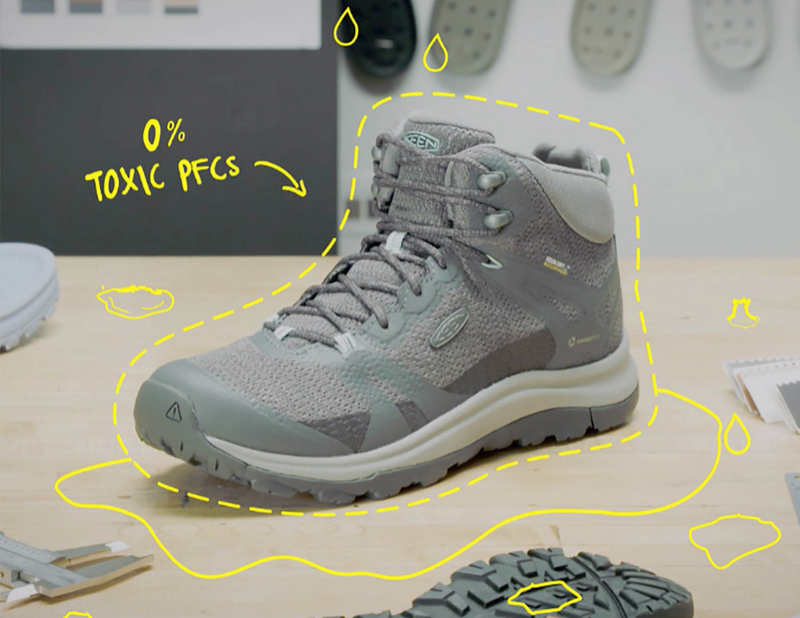
We want forever shoes, not “forever chemicals.”
A class of about 5,000 fluorinated compounds known as PFAS — or per- and polyfluoroalkyl substances — forever chemicals earned their nickname because of how persistent they are. These toxic chemicals never break down, remain in the environment, and enter the food chain. It’s a nickname we’re all becoming more familiar with as headlines continue to pop up about forever chemicals being found in everything from fast food wrappers to drinking water.
Five years ago, we discovered that they were in our shoes, too. Or, more accurately, on them. It turns out that the durable water repellency (DWR) treatments commonly used in outdoor apparel and footwear contain perfluorinated chemicals, or PFCs. In 2015, we took action to give them the boot.
THE PROBLEM WITH PFCS
PFCs are good at resisting a lot of elements — heat, oil, stains, grease, and water — which is why they’re used to treat everything from clothing and furniture to food packaging and non-stick cooking surfaces. But they don’t stay there. Traces of these toxic chemicals get into the environment and never go away. According to the Centers for Disease Control and Prevention (CDC), “Chemicals in this group have been a concern because they do not break down in the environment, and they build up in wildlife. PFCs have been found in rivers and lakes and in many types of animals on land and in the water.”
They’ve also been found in our blood. In the Fourth National Report on Human Exposure to Environmental Chemicals, CDC scientists measured 12 PFCs in the blood serum of 2,094 participants aged 12 years and older who took part in the National Health and Nutrition Examination Survey (NHANES) during 2003–2004.
The harm they cause to human health is less understood. But the CDC adds that PFCs may affect growth and development, reproduction, and injure the liver.
“IF YOU DON’T NEED IT, DON’T USE IT”
The first thing we did is perform a complete audit of every spec sheet of every shoe, and we discovered that PFCs were showing up in over 100 different components (!!!). It had become common practice in the footwear industry to coat every little part of a shoe: the laces, the stitching, the heel counter, and on and on.
We started asking: Why are we using non-wicking laces or non-wicking thread in a non-waterproof style? Why are we using a DWR finish on our sandals?
“Out of the gate, we realised we could stop using it on our non-waterproof styles, like our sandals,” says Chris Enlow, senior director of KEEN Effect, a team that guides our responsible manufacturing, advocacy, and philanthropy efforts. “We eliminated nearly 70 percent of our use of this class of chemistry without making any other changes. Just by stopping using it where we don’t need it.”

FINDING A SAFE ALTERNATIVE
For the remaining 30 percent, we needed to find an alternative that was safe, effective, and affordable. To start, we turned to Greenpeace and their list of 33 types of chemistries that they don’t want to see in waterproofing technologies. Following their strict guidelines, we found some effective alternatives that still met our performance standards, and we put in about 1,000 hours of field testing to make sure they lived up to our durability standards, too. (Here in Portland, we live in the perfect testing grounds!)
These safe alternatives aren’t as “strong” as PFC-based chemistries. And that’s OK. As we mentioned earlier, PFCs are effective at resisting stains, grease, and motor oil. But we just needed something that was effective at repelling water and dirt. In essence, a DWR with PFCs is over-engineered for hiking shoes. “We were using a formula that was doing things we didn’t need. The new, PFC-free solutions we found meet our standards around water and dirt. Not spaghetti sauce,” Chris says.

SOURCING IT EVERYWHERE (EASIER SAID THAN DONE)
With safe alternatives in hand, it might sound easy to make the transition to a PFC-free DWR. But we quickly realized that getting to 100% PFC-free was not going to be as quick and simple as flipping a switch.
To begin with, PFCs were being embedded in core components throughout the shoe (not just the upper). For a waterproof or water-resistant style, it meant specifying the face fabric, the thread, the foam inside the tongue, and over a hundred other individual pieces, including the KEEN logo. PFCs really are everywhere. It gets pretty complex, because we needed to work with many different suppliers and they in turn needed to work in their supply chain to source the chemistries that we wanted.
Plus, many factories were using it as a coating on their molding machinery — kind of like spraying muffin tins with non-stick cooking spray. So even parts of the shoe that wouldn’t normally have a DWR treatment specified had traces of PFCs in them. It was even in the packaging. So we hired a full-time restricted substances expert who could be on the ground in the factories to ensure that PFCs weren’t inadvertently ending up in our products.

10,000 HOURS SPENT, 150+ TONS OF PFCS SAVED
When we started this journey, we didn’t think it would take five years to eliminate PFCs from our supply chain. We’ve estimated that we’ve collectively spent about 10,000 hours getting to where we are today. In that time, we’ve saved over 150 tons of fluorinated chemicals from being introduced into the environment.
Five years ago, PFC-free was a new concept for our suppliers. Now, more brands are making the switch to PFC-free alternatives, and that’s been great to see. Every step makes an impact, and together we can make a bigger difference. As our “detox journey” keeps going, we continue to rethink every part of the shoemaking process to see where else we can do things differently and make a positive impact.
“We’re on a journey,” Chris says. “Everyone can think of a journey — you’re going down a trail for 10 miles. It takes time to get there. We should be really proud of what we’re doing, yet be humble and be honest with ourselves that we’re not perfect. Our effort to rid our products of PFCs is a big step forward, but we still have a long way to go.”
Source:
https://www.cdc.gov/biomonitoring/PFAS_FactSheet.html
